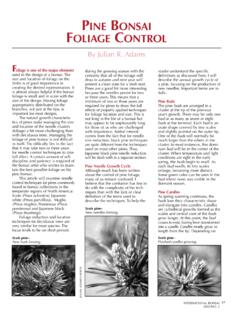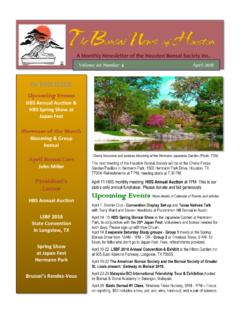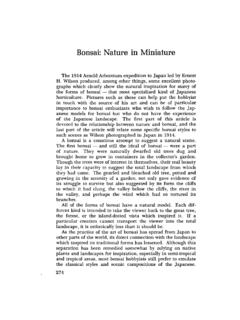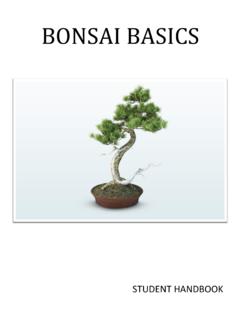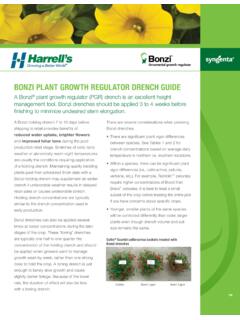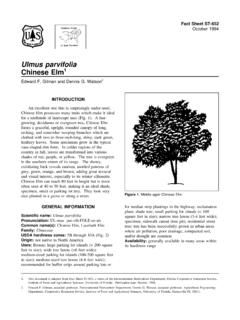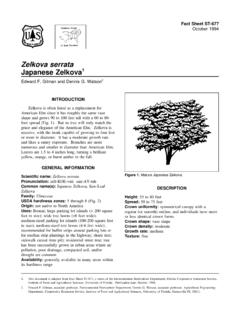Transcription of A Bonsai Close Up on Saikei
1 A Bonsai Close Up on Saikei By Pauline F Muth of pfm Bonsai studio copyrighted 2003, updated 2004 Saikei literally means living landscape. In this form of Bonsai , the artist depicts not just a tree or a forest but a full 3 dimensional landscape. In Japan the school of Saikei was founded by Toshio Kawamoto after World War II. He based this Bonsai art form on the principles of group plantings and rock plantings of Bonsai . Seeing the need for a form of Bonsai that would be easily accessible to the average person, he created Saikei . Young seedlings can be used and grown into older trees while they create a beautiful scene for us to enjoy. Kawamoto wanted a Bonsai form that could look lovely even when freshly planted unlike the many years true Bonsai takes to develop. His 1967 book, Saikei : Living Landscapes in Miniature has been the bible of Saikei since its introduction.
2 When Kawamoto introduced this style, he did not use any well-developed trees in his Saikei . As time passed, other artists took this style to higher levels by training each of the trees in the Saikei . Today Saikei can be designed with young seedlings or rooted cuttings or well developed Bonsai . The choice is yours and is only limited by the materials you have available and your skill and imagination. By studying landscapes in nature, we can envision Saikei we would like to construct. As you travel throughout the country, take pictures of various landscapes for inspiration. When constructed the Saikei will include rocks, trees, grasses, mosses and perhaps an accessory or two to complete the picture all staged on a beautiful tray or rock. Ulmus Land and Water Penjing Larix Saikei On Natural Rock First let us consider the nuts and bolts of Saikei .
3 What is needed for Saikei ? This is a general list; there will be cases where not all items would be used. A container (see list below) Small trees (see description of ideal traits of Saikei trees below) Rocks: these may need to be cut Grasses and small plants Mosses Accessories if desired Bonsai mediums (soils) appropriate for the species of trees Muck Wire Epoxy putty Hydraulic Cement Fiberglass dry wall tape Plastic needlepoint grid Bonsai tools and gloves Small plastic bags Grid or large paper and pencil What are the characteristics of a Saikei container? Shallow Sized in proportion to the amount of material you will work more room it usually better as it conveys good spatial relationships Shaped to reinforce the design Colored in harmony to the design Light and moveable once designed ..being able to move the final Saikei is critical to its care in the northeast Sturdy Have drainage (if no drainage holes are present, you may drill them or compensate by using a larger grain size drainage layer under the growing layer and modifying your watering technique to drain the basin after watering) Materials that make good containers: o Rock slab or slabs o Pottery o Cement (reinforced).
4 Consider using Ciment Fondue o can make you own containers o Three dimensional rocks What are the characteristics of good trees for Saikei ? Small leaves Short internodal spaces that create tight growth habits A good silhouette that looks like the fully grown tree even when young Firm, small well developed root ball that will allow you to work over a wider time period when designing your Saikei Tolerant of heat and cold and shade Long lived There are many species that work will in Saikei ; if the tree fits all the above characteristics it is worth a try. To prepare seedlings for Saikei : Grow seedlings or cuttings in small containers to allow transplanting at any time Keep the trees well trimmed and shaped Wiring can be done while in the training pot if you wish or later while in the Saikei Characteristics of grasses or ground cover plants to be used in Saikei : Naturally short with leaves Close to the ground Strong root system Spread rapidly in container conditions Hardy Shade tolerant Characteristics of mosses to be used in Saikei : Fine texture Short Good color that is retained throughout the year Tolerant of dryness Spreads easily Variety of species Bonsai mediums (soils) for Saikei .
5 Have excellent drainage Are well sifted Are dry to start with Match the needs of the species being used Need to be of at least two sizes o Larger grains for the base o Smaller grains for the main growing layer o Optional fine grains as a top finishing layer for mosses Ornaments for Saikei : Ornaments can be used with restraint in these landscapes to add to the visual illusion. Be sure they fit these requirements: Sized proportional to the landscape Delicate in design and color Used sparingly Fit the mood you are trying to create Rocks for Saikei : Illustrate full sized landscape rocks even through they are small Match in texture and color Will survive winter weather conditions Have shapes that replicate those in your vision of the landscape Step-by-Step Saikei 1. Sketch your idea for a Saikei . Make a full size diagram to plot your Saikei .
6 2. Assemble all the materials listed above. 3. Remember to wear gloves while handling soil mediums and nutrients. Some of these are harmful and can diffuse into your skin. 4. Prepare the trees for use by reducing the roots and wrap each root ball in plastic. If the trees can be shaped, wire them for later positioning. If the material is young, you may decide not to wire. 5. Arrange the rocks to create your landscape. These may be cemented in place with hydraulic cement or epoxy putty. 6. Once the cement is dry position the trees on the tray while they are still wrapped in plastic. Allow for land topography by placing small pots or rocks under the trees as you place them. 7. Remove the trees and place them on the plot diagram. 8. If you discover that your trees will not be able to stand on their own, set up wires to hold them by using epoxy putty to fasten them IF no holes are in the tray or slab.
7 9. Put a layer of coarse Bonsai medium on the base of the is especially needed if you are using a tray or slab without holes. If you are using a slab you may need to put a ring of muck around the planting area to hold the soil in. 10. Position the trees. Use muck under area where you want a higher topography. Fasten with wire where needed. 11. Add in micronutrients, chelated iron and rooting hormone under the trees. 12. Fill in around trees with Bonsai soil and chop stick in. 13. Water in the trees. 14. Add accessory plants and mosses. Be sure to use plants in scale and vary for mosses for good texture. Use darker colors under the trees and lighter colors in clear areas. At this point add in any ornaments you wish remembering the rules. 15. Gently water the whole planting. 16. IF you have not disturbed the roots of the plants, the Saikei will not need special care but if you have cut or disturbed the roots, put the Saikei in semi-shade for a week or two.
8 If constructed late in the season, greenhouse for the first winter if using hardy material. It is BEST constructed in spring. 17. Keep your Saikei trimmed and water. In time you may even decide to remove a tree or two from the Saikei to train as an individual Bonsai . 18. Transplanting is usually only needed after 4 or 5 years depending on the growth rates of the trees. 19. ENJOY your creation! Comments, corrections, additions and questions may be sent to Pauline F Muth pfm Bonsai studio 7 Western Avenue West Charlton NY 12010



